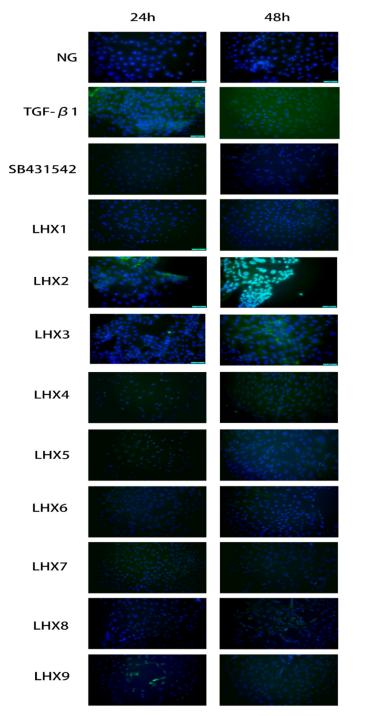| 产品: | EHMT2 抗体 |
| 货号: | DF6379 |
| 描述: | Rabbit polyclonal antibody to EHMT2 |
| 应用: | WB IHC |
| 文献验证: | |
| 反应: | Human, Mouse, Rat |
| 分子量: | 132kDa; 132kD(Calculated). |
| 蛋白号: | Q96KQ7 |
| RRID: | AB_2838342 |
产品描述
*The optimal dilutions should be determined by the end user. For optimal experimental results, antibody reuse is not recommended.
*Tips:
WB: 适用于变性蛋白样本的免疫印迹检测. IHC: 适用于组织样本的石蜡(IHC-p)或冰冻(IHC-f)切片样本的免疫组化/荧光检测. IF/ICC: 适用于细胞样本的荧光检测. ELISA(peptide): 适用于抗原肽的ELISA检测.
引用格式: Affinity Biosciences Cat# DF6379, RRID:AB_2838342.
展开/折叠
Ankyrin repeat containing protein; Bat 8; Bat8; C6orf30; DKFZp686H08213; EHMT 2; Ehmt2; EHMT2_HUMAN; Euchromatic histone lysine methyltransferase 2; Euchromatic histone lysine N methyltransferase 2; Euchromatic histone-lysine N-methyltransferase 2; FLJ35547; G 9a; G9 a; G9a protein; G9A; G9A histone methyltransferase; GAT8; H3 K9 HMTase 3; H3-K9-HMTase 3; Histone H3 K9 methyltransferase 3; Histone H3 K9 methyltransferase3; Histone H3-K9 methyltransferase 3; Histone lysine N methyltransferase; Histone lysine N methyltransferase EHMT2; Histone lysine N methyltransferase, H3 lysine 9 specific 3; Histone lysine N methyltransferase, H3 lysine 9 specific3; Histone-lysine N-methyltransferase EHMT2; HLA B associated transcript 8; HLA-B-associated transcript 8; KMT 1C; KMT1 C; Lysine N methyltransferase 1C; Lysine N-methyltransferase 1C; NG 36; NG36; Protein G9a;
抗原和靶标
A synthesized peptide derived from human EHMT2, corresponding to a region within N-terminal amino acids.
Expressed in all tissues examined, with high levels in fetal liver, thymus, lymph node, spleen and peripheral blood leukocytes and lower level in bone marrow.
- Q96KQ7 EHMT2_HUMAN:
- Protein BLAST With
- NCBI/
- ExPASy/
- Uniprot
MAAAAGAAAAAAAEGEAPAEMGALLLEKETRGATERVHGSLGDTPRSEETLPKATPDSLEPAGPSSPASVTVTVGDEGADTPVGATPLIGDESENLEGDGDLRGGRILLGHATKSFPSSPSKGGSCPSRAKMSMTGAGKSPPSVQSLAMRLLSMPGAQGAAAAGSEPPPATTSPEGQPKVHRARKTMSKPGNGQPPVPEKRPPEIQHFRMSDDVHSLGKVTSDLAKRRKLNSGGGLSEELGSARRSGEVTLTKGDPGSLEEWETVVGDDFSLYYDSYSVDERVDSDSKSEVEALTEQLSEEEEEEEEEEEEEEEEEEEEEEEEDEESGNQSDRSGSSGRRKAKKKWRKDSPWVKPSRKRRKREPPRAKEPRGVNGVGSSGPSEYMEVPLGSLELPSEGTLSPNHAGVSNDTSSLETERGFEELPLCSCRMEAPKIDRISERAGHKCMATESVDGELSGCNAAILKRETMRPSSRVALMVLCETHRARMVKHHCCPGCGYFCTAGTFLECHPDFRVAHRFHKACVSQLNGMVFCPHCGEDASEAQEVTIPRGDGVTPPAGTAAPAPPPLSQDVPGRADTSQPSARMRGHGEPRRPPCDPLADTIDSSGPSLTLPNGGCLSAVGLPLGPGREALEKALVIQESERRKKLRFHPRQLYLSVKQGELQKVILMLLDNLDPNFQSDQQSKRTPLHAAAQKGSVEICHVLLQAGANINAVDKQQRTPLMEAVVNNHLEVARYMVQRGGCVYSKEEDGSTCLHHAAKIGNLEMVSLLLSTGQVDVNAQDSGGWTPIIWAAEHKHIEVIRMLLTRGADVTLTDNEENICLHWASFTGSAAIAEVLLNARCDLHAVNYHGDTPLHIAARESYHDCVLLFLSRGANPELRNKEGDTAWDLTPERSDVWFALQLNRKLRLGVGNRAIRTEKIICRDVARGYENVPIPCVNGVDGEPCPEDYKYISENCETSTMNIDRNITHLQHCTCVDDCSSSNCLCGQLSIRCWYDKDGRLLQEFNKIEPPLIFECNQACSCWRNCKNRVVQSGIKVRLQLYRTAKMGWGVRALQTIPQGTFICEYVGELISDAEADVREDDSYLFDLDNKDGEVYCIDARYYGNISRFINHLCDPNIIPVRVFMLHQDLRFPRIAFFSSRDIRTGEELGFDYGDRFWDIKSKYFTCQCGSEKCKHSAEAIALEQSRLARLDPHPELLPELGSLPPVNT
研究背景
Histone methyltransferase that specifically mono- and dimethylates 'Lys-9' of histone H3 (H3K9me1 and H3K9me2, respectively) in euchromatin. H3K9me represents a specific tag for epigenetic transcriptional repression by recruiting HP1 proteins to methylated histones. Also mediates monomethylation of 'Lys-56' of histone H3 (H3K56me1) in G1 phase, leading to promote interaction between histone H3 and PCNA and regulating DNA replication. Also weakly methylates 'Lys-27' of histone H3 (H3K27me). Also required for DNA methylation, the histone methyltransferase activity is not required for DNA methylation, suggesting that these 2 activities function independently. Probably targeted to histone H3 by different DNA-binding proteins like E2F6, MGA, MAX and/or DP1. May also methylate histone H1. In addition to the histone methyltransferase activity, also methylates non-histone proteins: mediates dimethylation of 'Lys-373' of p53/TP53. Also methylates CDYL, WIZ, ACIN1, DNMT1, HDAC1, ERCC6, KLF12 and itself.
Methylated at Lys-185; automethylated.
Nucleus. Chromosome.
Note: Associates with euchromatic regions. Does not associate with heterochromatin.
Expressed in all tissues examined, with high levels in fetal liver, thymus, lymph node, spleen and peripheral blood leukocytes and lower level in bone marrow.
The SET domain mediates interaction with WIZ.
The ANK repeats bind H3K9me1 and H3K9me2.
In the pre-SET domain, Cys residues bind 3 zinc ions that are arranged in a triangular cluster; some of these Cys residues contribute to the binding of two zinc ions within the cluster.
Belongs to the class V-like SAM-binding methyltransferase superfamily. Histone-lysine methyltransferase family. Suvar3-9 subfamily.
研究领域
· Metabolism > Amino acid metabolism > Lysine degradation.
· Organismal Systems > Aging > Longevity regulating pathway. (View pathway)
文献引用
Application: IF/ICC Species: Mouse Sample: MTEC cells
限制条款
产品的规格、报价、验证数据请以官网为准,官网链接:www.affbiotech.com | www.affbiotech.cn(简体中文)| www.affbiotech.jp(日本語)产品的数据信息为Affinity所有,未经授权不得收集Affinity官网数据或资料用于商业用途,对抄袭产品数据的行为我们将保留诉诸法律的权利。
产品相关数据会因产品批次、产品检测情况随时调整,如您已订购该产品,请以订购时随货说明书为准,否则请以官网内容为准,官网内容有改动时恕不另行通知。
Affinity保证所销售产品均经过严格质量检测。如您购买的商品在规定时间内出现问题需要售后时,请您在Affinity官方渠道提交售后申请。产品仅供科学研究使用。不用于诊断和治疗。
产品未经授权不得转售。
Affinity Biosciences将不会对在使用我们的产品时可能发生的专利侵权或其他侵权行为负责。Affinity Biosciences, Affinity Biosciences标志和所有其他商标所有权归Affinity Biosciences LTD.

